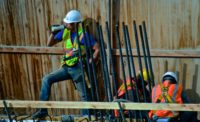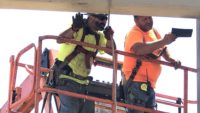The U.S. Occupational Safety and Health Administration is seeking comments on future rules on workplace heat hazards that will affect construction and other industries.
OSHA, part of the U.S. Dept. of Labor, published its advance notice of proposed rulemaking for heat injury and illness prevention in outdoor and indoor work settings on Oct. 27.
The advance notice points to a growing problem of heat-related problems in a variety of industries, saying that heat is the leading cause of death among weather-related workplace hazards. In August, an NPR analysis of Bureau of Labor Statistics data found that the three-year average of worker heat deaths had doubled since the early 1990s. BLS says environmental heat exposure at work caused an average 2,700 cases per year that resulted in days away from work from 2011 to 2019, including an average of 38 deaths per year. About 42% of the workers who died from heat-related issues from 2011 to 2019 were engaged in construction, repair or cleaning.
Those figures likely don’t even account for all heat-related workplace health incidents. Officials believe that workers’ heat-related illnesses are underreported, Jim Frederick, OSHA acting assistant secretary, said in a statement.
OSHA says in the notice that it will be looking at causes of workplace heat-related health issues such as heat-generating work practices, exertion level, weather and location in direct sunlight or shade, as well as individual factors like age and underlying health conditions. The agency will consider strategies to reduce heat-related injury and illness, such as engineering controls including AC or ventilation, administrative controls like changes to workloads or schedules and PPE including cooling vests and similar equipment.
Setting an Example
There are several places where OSHA may look for ideas in its rulemaking.
Four states — California, Minnesota, Oregon and Washington — already have hazardous heat standards in place for employers. While different in each state, those standards include requirements for factors including hydration, shade, breaks, training and medical response plans. Virginia officials are also considering a standard. Colorado, Maryland and Nevada now require officials in their respective states to create their own workplace heat rules.
U.S. military branches have their own heat-related guidelines.The Army Heat Center at Fort Benning, Ga. ise focused on the research and prevention of heat-related illnesses and deaths.
There are also industry-created guidelines that could inform OSHA’s rulemaking. The American National Standards Institute/American Society of Safety Professionals A10 Committee proposed construction and demolition workforce heat stress standards in 2019. Construction industry groups including the Associated General Contractors of America, Associated Builders and Contractors and American Road & Transportation Builders Association also have guidance for their members. Industry groups also plan to participate in the rulemaking process.
In its own guidance, AGC considers local worker acclimatization—an 80° heat wave in Alaska could impact workers there more than a 99° day in the summer in Arizona, says Brian Turmail, vice president of public affairs and strategic initiative
"We do think there's probably a good way to go about creating a rule that protects workers and is reasonable for contractors," he says. "As we work to respond to OSHA's request, we'll provide them with information about how to create a standard that would be effective and workable."
OSHA’s move to begin the rulemaking comes after the Biden administration announced a multi-agency push in September to protect workers and communities from extreme heat in response to record heat in parts of the U.S. during the summer of 2021, with projections that climate change will lead to more extreme weather in the future.
“As we continue to see temperatures rise and records broken, our changing climate affects millions of America's workers who are exposed to tough and potentially dangerous heat,” Labor Secretary Marty Walsh said in a statement. “We know a disproportionate number of people of color perform this critical work and they, like all workers, deserve protections.”
OSHA is also making other heat-related efforts. In September, the agency announced it had started an enforcement initiative on heat-related worker illnesses and deaths, prioritizing inspections at worksites on days when the heat index rises above 80°F or other heat hazards could impact workers.
The National Advisory Committee on Occupational Safety and Health also is forming a heat injury and illness prevention work group with representatives from industry groups, labor and others to identify challenges and best practices to protect workers.
Comments can be submitted on the proposed rule advance notice through Dec. 27 at regulations.gov. Instructions are available in the Federal Register.






Post a comment to this article
Report Abusive Comment